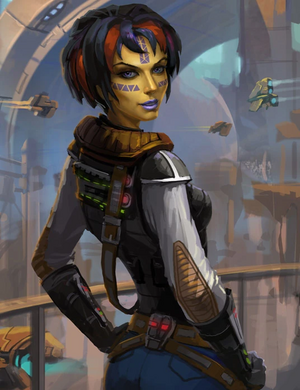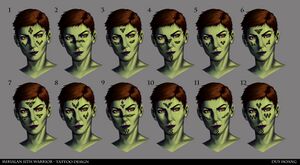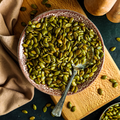Mekagrani (A1-0): Difference between revisions
No edit summary Tag: 2017 source edit |
No edit summary Tag: 2017 source edit |
||
| Line 34: | Line 34: | ||
}} | }} | ||
{{Quote|''" | {{Quote|''"We Mekagrani are inseparable from our Mekarrist ways. Our belief is written on our skin and marks each individual's identity. To ask us "''|Shiorna Mutlas}} | ||
The '''Mekagrani''' (singular: Mekagran, plural: Mekagrani/Mekagrans, adjective: Mekagran) (Trianarö: Mekagrûlö) are a spiritual people hailing from their lush homeworld [[Mirall (A1-0)|Mirall]]. It's speculated that they originated from a lost colony of [[Humans (A1-0)|humans]], the Mekagrani evolved to have greenish skins due to the consumption of the local flora which has affected their genome. After a few centuries of living free under the Mekagran Prelacy, the Mekagrani were subjugated roughly 30 BBT by the [[Trianar (A1-0)|Holy Imperium of Trianar]]. | The '''Mekagrani''' (singular: Mekagran, plural: Mekagrani/Mekagrans, adjective: Mekagran) (Trianarö: Mekagrûlö) are a spiritual people hailing from their lush homeworld [[Mirall (A1-0)|Mirall]]. It's speculated that they originated from a lost colony of [[Humans (A1-0)|humans]], the Mekagrani evolved to have greenish skins due to the consumption of the local flora which has affected their genome. After a few centuries of living free under the Mekagran Prelacy, the Mekagrani were subjugated roughly 30 BBT by the [[Trianar (A1-0)|Holy Imperium of Trianar]]. | ||
| Line 68: | Line 68: | ||
The teachings of Mekarrism may only be taught by female Mekagrani as it is believed that only they can hold ultimate wisdom or 'Mekarva' for conceiving life. In addition, only women who have given birth at least once may become priestesses colloquially called 'Geruna' (plural: Gerune). These are revered by Mekagrani culture at large and are often sought out for council. Each Mekagrani may come to a Geruna to ask for guidance to which the Geruna will often reply in cryptic prophecies. Outsiders have been known to frown upon the practice due to the usage of hallucinogens known as 'Ehraz' spice, yet the practice remains heavily entrenched in the spirituality of Mekagrani. | The teachings of Mekarrism may only be taught by female Mekagrani as it is believed that only they can hold ultimate wisdom or 'Mekarva' for conceiving life. In addition, only women who have given birth at least once may become priestesses colloquially called 'Geruna' (plural: Gerune). These are revered by Mekagrani culture at large and are often sought out for council. Each Mekagrani may come to a Geruna to ask for guidance to which the Geruna will often reply in cryptic prophecies. Outsiders have been known to frown upon the practice due to the usage of hallucinogens known as 'Ehraz' spice, yet the practice remains heavily entrenched in the spirituality of Mekagrani. | ||
Consequently, 'Ehraz' spice is considered one of the most precious substances to the Mekagrani. It's only found within bioluminescent 'Khenet' | Consequently, 'Ehraz' spice is considered one of the most precious substances to the Mekagrani. It's only found within bioluminescent 'Khenet' clams that are only found in shallow water caves within 5 degrees of latitude from the equator. These caves are known to the Mekagrani as 'Lellar' (plural: 'Lellahre') or 'Water Light'. Due to their religious significance, the caves are often also inhabited by Sodalities and considered sacred spaces. | ||
<gallery> | <gallery> | ||
Revision as of 22:55, 3 July 2023
 A female Mekagrani ruffian | |
 A male Mekagrani smuggler | |
| Biological Classification | |
|---|---|
| Designation | Sapient |
| Classification | Humanoid |
| Ancestral species | Humans |
| Races | Trorran Morkan Penerr Chunarall |
| Related subspecies | Alari Arkanians Dhaneghulans Jhadorans Panuri Prill Xalarians |
| Related species | Chiss/Cheunh Owette Zeltrex |
| Physical characteristics | |
| Average height | 1,74 m |
| Skin colour | Orange, yellow, green, dark green |
| Eye colour | Brown, silver, orange, yellow, red, green |
| Hair colour | Orange, brown, grey, white, green |
| Breathe | Oxygen |
| Lifespan | 86 standard years |
| Maturity | 18 standard years |
| Sexes | 2 |
| Distinctions | Facial tattoos |
| Sociocultural characteristics | |
| Place of origin | Mirall |
| Star nation | |
| Total population | ~1.52 trillion |
| Key worlds | Mirall, Inorro, Antall |
| Languages | Mekamon (common) Grapas Shiro Tizfan Manzis |
| Religion | Mekarrism |
| Marital customs | Monogamous |
| Notable individuals | Vajasho Druki Shiorna Mutlas Pamuka Punsher Mansho Bovasra |
"We Mekagrani are inseparable from our Mekarrist ways. Our belief is written on our skin and marks each individual's identity. To ask us "—Shiorna Mutlas
The Mekagrani (singular: Mekagran, plural: Mekagrani/Mekagrans, adjective: Mekagran) (Trianarö: Mekagrûlö) are a spiritual people hailing from their lush homeworld Mirall. It's speculated that they originated from a lost colony of humans, the Mekagrani evolved to have greenish skins due to the consumption of the local flora which has affected their genome. After a few centuries of living free under the Mekagran Prelacy, the Mekagrani were subjugated roughly 30 BBT by the Holy Imperium of Trianar.
Biology and appearance
The most notable feature of the Mekagrani are their greenish skins. This is an evolutionary side-effect of eating the mutated form of chlorophyll found in the fauna of Mirall over the course of centuries. However, this doesn't give the Mekagrani any ability at photosynthesis. Instead, the Mekagrani have evolved to contain a largely omnivore diet.
In addition to their greenish skin, the species also has seen its hair colour influenced to reddish & green colours. Even though reddish colours aren't recessive like in most humans, there are still cultural connotations associated with different hair colours. Reddish colours are often associated with playful & joyful characters, while dark green is seen as a sign of solemnity. White hair is seen as a sign of wisdom and unlike most humanoids, their hair turns white or grey at a much earlier stage in life. Roughly half the population has full white hair by the age of 45 standard years. It's also not uncommon to colour hair with a bleached strike to simulate white hair. This is often seen as a gerontocratic tendency of Mekagrani culture.
Another peculiar characteristic of the Mekagrani is that they have much fewer wrinkle formations with age. Their skin is considered the softest & most hydrated among all humanoid species. This results in many species perceiving members of the species as much younger than they actually are. As a result, The Mekagrani put much more emphasis to prove their accomplishments & age through hair styling and Miherric facial tattoos.
History
Early Mirall history
Mekagran Prelacy
Trianarö Annexation & subjugation
In the year 27 BBT, Colonization in the Southern Red Nebula slowed down due to slow terraformation rates and a lack of potential habitable planets. This led them to look towards the nation of Mekagrûl. They known of the state's existence going back to before the Hemmerhaldian War and had trade relationships with it. However, with colonization slowing down, and the state's proximity to the Imperium Territory where the Ikaranareans primarily lived, the Imperö Ankan Erras decided to take direct control. About 10,000 Trianarö ships flooded the region. After destroying the limited naval assets there, they landed on Mirall, forcing a capitulation of nearly all systems. Trianarö ground troops flooded the areas still putting up what limited resistance they could put up. With heavy armored pushes combined with technological and numerical superiority, the remaining resistance was easily stamped out.
The Trianarö indoctrinated the Mekagrani primarily by taking their children and educating them at schools on other planets. They also kept order with the patrols of the radical Izarenattikai who would ensure that any disrespect to Trianarö principles would be punished severely, while those who adhered to the principles and showed their faith in the Gods and the Ikaranareans were rewarded. In this way, the Trianarö aimed to force a society where nonbelievers were killed off or silenced while believers prospered.
Society and culture
Mekagran society & culture is defined by its spirituality. The essence of Mekagran culture is the balance between an individual's free will and the cosmic will, known as Mekarra. Because of this, Mekagrani put a lot of importance on wisdom and have gerontocratic tendencies. As can be seen in the historic Mekagran Prelacy, tribal structures & Mekarra religion.
Mekarrism
'Mekarra' is what the Mekagrani call the cosmic will or divine essence which guides the universe. Though the Mekagrani don't believe that their fate is predetermined by Mekarra as other religions who put heavy emphasis on fate, they believe to have some influence through their own free will. A balance between the two wherein one has enough freedom, but still listens to signs from the universe to guide their life, is what Mekagrani aim for.
The teachings of Mekarrism may only be taught by female Mekagrani as it is believed that only they can hold ultimate wisdom or 'Mekarva' for conceiving life. In addition, only women who have given birth at least once may become priestesses colloquially called 'Geruna' (plural: Gerune). These are revered by Mekagrani culture at large and are often sought out for council. Each Mekagrani may come to a Geruna to ask for guidance to which the Geruna will often reply in cryptic prophecies. Outsiders have been known to frown upon the practice due to the usage of hallucinogens known as 'Ehraz' spice, yet the practice remains heavily entrenched in the spirituality of Mekagrani.
Consequently, 'Ehraz' spice is considered one of the most precious substances to the Mekagrani. It's only found within bioluminescent 'Khenet' clams that are only found in shallow water caves within 5 degrees of latitude from the equator. These caves are known to the Mekagrani as 'Lellar' (plural: 'Lellahre') or 'Water Light'. Due to their religious significance, the caves are often also inhabited by Sodalities and considered sacred spaces.
-
A young Mekarrist priestess known as a 'Geruna'.
-
A 'Geruna' utilising luminescent 'Ehraz' hallucinogen.
-
A member of the 'Gerunall Sadorsall' otherwise known as the Grand Sodality.
-
'Lellar' cave at the equator of Mirall.
'Gerune' will often band together within a tribe and form a sodality which offers council to each tribe. Though over the course of Mekagran history, as the different tribes united, a Grand Sodality (Mekamon: Gerunall Sadorasall) was formed to unify the teachings. This religious institution remains intact to this day and is an important aspect of the overarching Mekagran culture.
Miherric - Tattoos

Cuisine
Roasted 'Kusraz' seeds are the most widespread seeds used in Mekagran cuisine. A favourite snack among the Mekagrani population, the seeds add a ton of taste to many traditional dishes and provide extra crunch. It's noted that this seed is rich in Mirall's mutated chlorophyll.
'Reggin' is an unleavened flatbread that is most commonly used to accompany meals or to put toppings on top of it. It's made out of a special yeast from Mirall that has unique growing capabilities as it even grows in the tundra landscapes within Mirall's arctic circle.
'Chumbalarv' is a dish with origins in the equatorial & monsoon regions of Mirall. It's commonly made of various fried vegetables, fish, crustaceans & avians served with fried unleavened wheat dough. Commercially, 'Chumbalarv' is seen as the most successful dish as it has gained outsider demand.
'Kibberz' is the most popular meat dish. It is made by frying meatballs, typically of avian animals, in hot oil until a crunchy crust envelops the entire meatball. Meat in Mekagran cuisine often takes the form of this general principle.
'Churraz' is considered the most ancient dish of the Mekagrani. It's made by installing meat on skewers which are then grilled either directly or indirectly.
-
Roasted 'Kusraz' seeds in a snack bowl.
-
Reggin bread with a 'Kibberz' & vegetable topping.
-
A served 'Chumbalarv' dish.
-
'Kibber' meatballs.
-
'Churraz' skewer grilled meat.
Naming conventions
Mekagrani in Sector A1-0
Most Mekagrani currently live under the authority of the Ikaranareans as subjects. However, there are still enclaves that established themselves in the Tiyanki Territories prior to the subjugation. While small in size, they have formed tight-knit communities that have persevered the test of time. Most of these Mekagrani have endeavoured into the shipping & smuggling business, making fortunes through various shipping lanes. This as a result gave them a reputation as smugglers & ruffians.
Derogatory terms
Although uncommon due to their amicable nature, sometimes the Mekagrani do face discrimination. Their subjugation by the Holy Imperium of Trianar is the foremost example of active discrimination against their species. Nonetheless, some members were able to flee the persecution and were occasionally faced with derogatory terms including but not limited to 'green skin', 'scab marks', 'ogre' & 'char skin'








